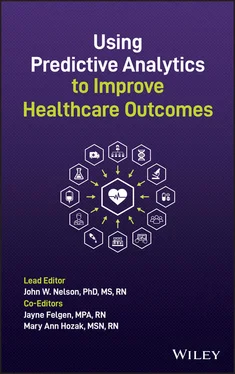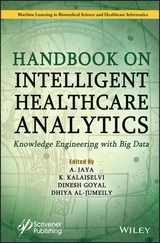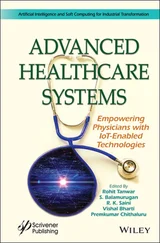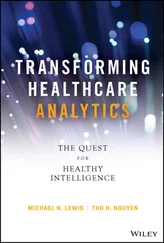Using Predictive Analytics to Improve Healthcare Outcomes
Здесь есть возможность читать онлайн «Using Predictive Analytics to Improve Healthcare Outcomes» — ознакомительный отрывок электронной книги совершенно бесплатно, а после прочтения отрывка купить полную версию. В некоторых случаях можно слушать аудио, скачать через торрент в формате fb2 и присутствует краткое содержание. Жанр: unrecognised, на английском языке. Описание произведения, (предисловие) а так же отзывы посетителей доступны на портале библиотеки ЛибКат.
- Название:Using Predictive Analytics to Improve Healthcare Outcomes
- Автор:
- Жанр:
- Год:неизвестен
- ISBN:нет данных
- Рейтинг книги:5 / 5. Голосов: 1
-
Избранное:Добавить в избранное
- Отзывы:
-
Ваша оценка:
- 100
- 1
- 2
- 3
- 4
- 5
Using Predictive Analytics to Improve Healthcare Outcomes: краткое содержание, описание и аннотация
Предлагаем к чтению аннотацию, описание, краткое содержание или предисловие (зависит от того, что написал сам автор книги «Using Predictive Analytics to Improve Healthcare Outcomes»). Если вы не нашли необходимую информацию о книге — напишите в комментариях, мы постараемся отыскать её.
Discover a comprehensive overview, from established leaders in the field, of how to use predictive analytics and other analytic methods for healthcare quality improvement. Using Predictive Analytics to Improve Healthcare Outcomes
before
proven in advance
Using Predictive Analytics to Improve Healthcare Outcomes
Using Predictive Analytics to Improve Healthcare Outcomes — читать онлайн ознакомительный отрывок
Ниже представлен текст книги, разбитый по страницам. Система сохранения места последней прочитанной страницы, позволяет с удобством читать онлайн бесплатно книгу «Using Predictive Analytics to Improve Healthcare Outcomes», без необходимости каждый раз заново искать на чём Вы остановились. Поставьте закладку, и сможете в любой момент перейти на страницу, на которой закончили чтение.
Интервал:
Закладка:
The notion that “caring contributes to healing” is a paradigm held closely by people in various disciplines in healthcare, and it is the very core of the profession of nursing (Lazenby, 2017). This chapter discusses the paradigm that caring contributes to healing, and it describes a number of frameworks of care delivery that seek to operationalize and systematize caring behaviors and to promote, support, and nurture caring in all relationships in healthcare. Nursing has done an excellent job of generating caring theories and frameworks of care delivery, but a poor job of creating an argument rooted deeply enough in verifiable data and scientific rigor to convince the broader scientific community that caring contributes to healing. This book makes a scientific argument that caring does indeed contribute to healing. This chapter reviews the theories and frameworks that have been tested throughout this book. Watson's Theory of Transpersonal Caring (2008a) is the predominant theory of caring science, and Relationship‐Based Care® (Creative Health Care Management, 2017; Koloroutis, 2004) is the predominant framework of care. However, there are other caring theories and frameworks of care that are reviewed in this book as well.
A special note is made here about the framework of care called the Caring Behaviors Assurance System ©(CBAS), because it is the framework of care for which there currently exists the most specified measurement instruments to capture the overall effectiveness of its implementation and outcomes and thus the argument that caring contributes to healing. Chapters 17and 18provide a thorough description of CBAS as well as a review of how its effectiveness has been successfully measured. It will not be reviewed in detail in this chapter on theory and frameworks because it is so thoroughly reviewed later and because earlier case studies in this book are taken from organizations using other frameworks of care.
Maturation of a Discipline
Nurses have revolutionized healthcare at least twice. Florence Nightingale's reformation of care delivery is the most well‐known example. Prior to Nightingale, care delivery was provided by monks and nuns of religious traditions (Goodnow, 1929). Nightingale's method of care delivery in 1854 espoused the need for a clean environment and individualized care of the patient (Nightingale, 1959). By insisting on a clean environment, she ensured that germs were not spread as rampantly from patient to patient. In effect, her adoption and enforcement of the paradigm “environments of care must be clean” improved patient safety. Germs and how disease spread were not clearly understood in the mid‐1800s, but scientific advancement is often discovered by accident (Kuhns, 1962). Nightingale's ability to document a decrease in mortality rate from 42.7% to 2.2% for soldiers in the Crimean war gained worldwide attention which resulted in her woman‐only model of nursing becoming the standard of care across the globe (McDonald, 2001; Neuhauser, 2003).
A second occurrence in which a nurse revolutionized healthcare is less well known. It was led by Agatha McGaw, a surgical nurse. It was McGaw who in the 1890s observed that patients often underwent surgery with great trauma and risk due to the methods used for anesthesia. It was her belief that this trauma and the associated deaths were due to the administration of too much anesthesia and/or the rapidity with which anesthesia was being administered. In response, she developed a method of administering anesthesia to patients by dropping the anesthesia medication into a cloth that was placed over the patient's nose and mouth. The anesthesia was taken in by the patient as the patient inhaled. The rate of dropping fresh anesthesia onto the cloth covering the patient's nose and mouth was adjusted based on the patient's rate of breathing, with fewer drops applied when the patient's breathing slowed, and more drops applied when the breathing rate increased. Using this method of administering anesthesia, she recorded giving anesthesia to 14,000 patients, none of whom died. Her observation of the patient, and adjusting treatment to the patient's response, resulted in the establishment of the profession of anesthesiology and a new paradigm of how anesthesia was administered, based on the patient's observed physical response (Koch, 1999; Pougiales, 1970).
Could the effectiveness of caring, as a proven way to hasten healing, be the third medical revolution put forth by nursing? Watson (a nurse) asserts that when nurses enact caring behaviors toward themselves and/or others, healing is facilitated (2008a). This is yet another paradigm that has come to be espoused by nurses around the world. While there was a surge of caring theories in the 1970s and 1980s, a recent search revealed that Watson's theory is the most referenced caring theory in literature, and it is the theory researched most extensively in this book. It is the conclusion of the editors and authors of this book and all of its chapters that the observable presence of caring behaviors is an important predictor of a satisfying and safe healthcare experience—both for patients and for providers in all roles and disciplines. All studies in this book took place in institutions pursuing implementation of caring behaviors using frameworks of care that espoused the importance of caring for both self and others. While outcomes indicate dramatic improvement due to the contributions of Nightingale and McGaw, such outcomes proving that caring for self and others improves patient health and nurse satisfaction are newer and fewer. This book contains research that goes a long way to solidify the paradigm “caring contributes to healing” as an evidence‐based reality.
It is the intent of the many authors of this book to find the best theory or combination of theories to demonstrate not only that caring contributes to healing, but that the frameworks of care, through which caring behaviors are supported within systems of care, have inestimable value. We are at the point in this work where Benjamin Franklin was, just prior to his discovery of electricity. Prior to his famous encounter with the lightning bolt, there were several other theorists working on understanding electricity (Kuhn, 1962). It was not until Franklin considered the similarities of all the theories, and conducted a fascinating experiment with liquid electricity in a jar called a Layden jar, that Franklin's work resulted in what we now know as electricity as well as a profession for electricians to practice (Kuhn, 1962). Will one or more of the case studies in this book be the lightning bolt that shifts healthcare into a more complete and irrevocable understanding that caring contributes to healing?
Will one or more of the case studies in this book be the lightning bolt that shifts healthcare into a more complete and irrevocable understanding that caring contributes to healing?
Theory
Nursing works closely with medicine and other healthcare professions, but nurses are unique in that they are with the patient 24 hours a day and have the most consistent contact with the patient during care. This requires nurses to work within the systems of the organization and thus it is important to not only study nursing's many theories of caring, but how that caring is enabled or hindered by the social and technical aspects of the work environment.
Caring Theory
There are several theories of caring proposed in the profession of nursing, all asserting that caring is an important part of the healing process in care delivery. The most commonly cited theories are Watson's Theory of Human Caring (1979, 1985) and her more contemporary Theory of Transpersonal Caring (2008a). Several theorists have amended Watson's theory by adding concepts or combining it with other theories, including Duffy's Quality Caring Nursing Model (Edmundson, 2012), and Caroline Coates' theory (1997) which combines Watson's Theory of Transpersonal Caring with Bandura's concept of self‐efficacy. Swanson's Theory of Caring Behaviors was derived from research Swanson conducted in obstetrics, which took into consideration the care experiences of both mothers and fathers (1999). The theories of both Watson and Swanson have been applied extensively in the studies reviewed in this book.
Читать дальшеИнтервал:
Закладка:
Похожие книги на «Using Predictive Analytics to Improve Healthcare Outcomes»
Представляем Вашему вниманию похожие книги на «Using Predictive Analytics to Improve Healthcare Outcomes» списком для выбора. Мы отобрали схожую по названию и смыслу литературу в надежде предоставить читателям больше вариантов отыскать новые, интересные, ещё непрочитанные произведения.
Обсуждение, отзывы о книге «Using Predictive Analytics to Improve Healthcare Outcomes» и просто собственные мнения читателей. Оставьте ваши комментарии, напишите, что Вы думаете о произведении, его смысле или главных героях. Укажите что конкретно понравилось, а что нет, и почему Вы так считаете.












